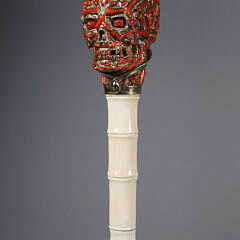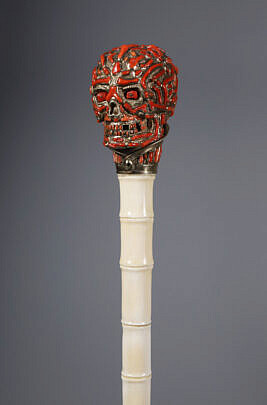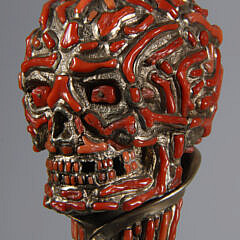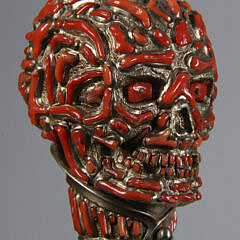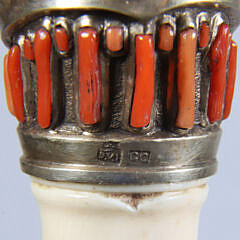- DeptWalking Sticks and Canes
- SizeLength 36 in.
Silver and Coral Skull Grip Walking Stick designed and executed by Giuseppe Caltagirone, Sicily, Italy c. 1790-1810, signed and hallmarked with intricate channel set coral in silver, six section faux bamboo antique ivory shaft
Length 36 in.
Provenance: The Estate of Eddi Van Auken
To Be Included in the Forthcoming Book: Masterpieces, The Eddi Van Auken Collection of Antique Walking Sticks and Canes
Designed and executed by Giuseppe Caltagirone, Sicily, Italy, c. 1790–1810, signed, hallmarked. Red coral, silver gilt. Sectioned bone shaftOverall length: 36 1/4 in. Handle: height: 2 3/4 in.; width: 2 1/4 in.A dramatic example of memento mori in which the skull is rendered in a challenging technique associated for centuries with the red coral of Trapani, Sicily, among the world’s most precious corals. A silver-gilt frame is meticulously sculpted with deep pockets into which conforming pieces of carved and polished red coral are individually set. It is an exacting art with stunning results.Trapani is a port city on the west coast of Sicily known for its coral harvests, which are one of its primary exports. Its vividly red native coral is relatively soft and polishes well, facilitating its use in what are sometimes complex pieces. Trapani works have long been highly desired for their intricate workmanship and striking effect. Examples of Trapani ware (made by highly skilled craftsmen known as corallai) are in Trapani’s Museo regionale Agostino Pepoli, housed in the fourteenth-century Convento dei Carmelitani, and in many other museums, including the Hermitage. Some pieces are simply carved coral; others are elaborate. The splendid example of Trapani work in this cane was executed by Giuseppe Caltagirone, who worked from 1792 to 1812. Coral, considered a charm against evil, has its own mystique: in Greek mythology, coral was transformed from seaweed that had been washed with the blood of Medusa, who so angered Athena that the goddess punished Medusa by turning her hair into snakes and making her so ugly that the sight of her turned onlookers into stone.Memento mori art speaks to mortality, the vanity of life, and the inevitability of age, loss, and decay. Translated from Latin, the phrase means “Remember that you will die,” and a frequent depiction is a ghoulish skull, as in this rare Trapani example. Often an artist will juxtapose a youthful image, often female, with that of a skull, aiming for maximum spookiness. When the theme appears in Old Master still-life paintings, it is usually symbolized by overripe food, a dead or dying blossom, or, less subtly, a skull.Images that remind us our lives on earth are short are probably as old as humankind and its various theologies. In the name of memento mori, religions over the millennia have presented incredible spectacles. High on the list is Rome’s ossuary (a popular tourist attraction) in the catacombs of Santa Maria della Concezione dei Cappuccini on the Via Veneto. The church and an adjacent Capuchin monastery were built by Pope Urban in the early seventeenth century. Upon its completion in 1631, the monks moved in, bringing their possessions and four thousand dead brethren whose skeletal remains were dug up and transported in three hundred cartloads. In their new—and current—home, the bones were used to create artful designs and tableaus in the subterranean crypt, comprising five small chapels off a central corridor. (By some accounts, the pope also ordered soil to be brought from Jerusalem for use in the crypt.) The surfaces of each room are adorned with bones from the relocated corpses, believed to have accumulated from 1500 to 1800.
Please note that this auction has ended.
Click here for an overview of this auction.

